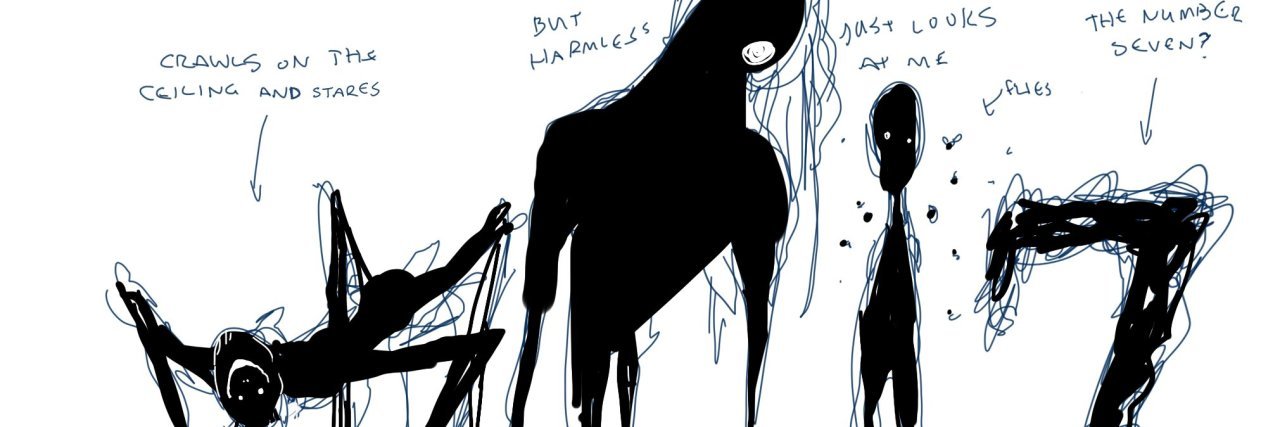Waking up and temporarily not being able to move your body is already scary. But a tweet challenging social media users to draw their “sleep paralysis demons” highlights another scary element of a sleep paralysis episode.
On Feb. 6, Twitter user Rachel challenged followers to share their sleep paralysis drawings. Her own sleep paralysis image depicts four characters in black and white — an insect-looking creature who, Rachel writes, “crawls on the ceiling,” a tall figure she labels as “loud and scary but harmless,” a smaller figure who just looks at her surrounded by flies and what she said seems to be the number seven.
draw ur sleep paralysis demons challenge pic.twitter.com/iC6H7XkgH0
— rachel ❄️ (@rhymewithrachel) February 6, 2019
The Twitter thread now has nearly 35,000 likes and 10,000 comments, including posts from others who have added their own creative depictions of their own sleep paralysis demon stories.
heres mine. i drew this on my phone pls no judge pic.twitter.com/w47bH4C8My
— Laværis (@lavaeris_lavvy) February 6, 2019
i get drug(medicine) induced sleep horrors. i can only sometimes interact with/during them. pic.twitter.com/YbzLDR80br
— bear (@dogtreat_) February 6, 2019
Mine is the dude in the back, he likes to mimic the voices of my loved ones and say really mean things to me. I call him Shadowman. He just needs some love.
The other ones are just personifications of my narcolepsy and cataplexy haha pic.twitter.com/F1djtFQzJr
— ????Cryptid Colleen???? (@Slothakiin) February 6, 2019
mine looks like a dumb pirate pic.twitter.com/jwC23jJF0z
— Levon Jihanian (@ForkFrenzy) February 6, 2019
It’s not surprising so many people would represent their sleep paralysis with sometimes threatening and intrusive images. Sleep paralysis is a well-known phenomenon across many cultures. When people report thinking they were abducted by aliens or possessed by demons, it’s sometimes believed to be the result of sleep paralysis.
What Is Sleep Paralysis?
Sleep paralysis can occur when you wake up before your body moves out of rapid eye movement (REM) sleep, the last of a full five-part sleep cycle. During REM sleep, your mind becomes active and you’re most likely to dream. To prevent your body from acting out your dreams (like running away from a threat, for example), your brain disconnects its motor neurons so you can’t move.
Alcibiades Rodriguez, MD, medical director of NYU Langone Health’s Sleep Center, told The Mighty that when you wake up suddenly out of REM sleep, however, your body may remain in its paralyzed REM sleep state. As a result, you will be awake and conscious but completely unable to move your body for a short amount of time, usually less than a minute but up to a few minutes, Rodriguez said.
Sometimes during an episode, you might also feel like you can’t breathe or have hallucinations, essentially dreaming while awake, according to Rodriguez. These hallucinations could be the sensation of an evil presence (intruder hallucination), feeling like there’s something on your chest (incubus hallucination) or feeling movement when there is none (vestibular-motor hallucinations). People often refer to these hallucinations as sleep paralysis demons.
How Common Is Sleep Paralysis?
While an estimated 30 percent of the population will experience an episode of sleep paralysis in their lifetime, recurrent episodes may indicate an underlying condition. It’s most strongly correlated with narcolepsy, a sleep disorder that causes you to fall asleep during the day, among other symptoms.
Sleep paralysis also seems more common if you have a mental health condition with an anxious or fight-flight component such as panic disorder or post-traumatic stress disorder (PTSD). Other studies suggest it may happen more often along with substance abuse or some chronic illnesses. There also seems to be a genetic component related to who experiences sleep paralysis.
How to Cope With Sleep Paralysis
To cope with sleep paralysis, Rodriguez recommends not sleeping on your back when possible and taking steps to reduce your anxiety overall. If you have recurrent episodes, check in with your doctor to evaluate for sleep disorders like narcolepsy, mental health conditions and other potential underlying causes. You may also be prescribed a low-dose antidepressant.
Though many expressed fear and discomfort about sleep paralysis hallucinations and “demons,” some who commented on Rachel’s tweet found other creative ways to manage sleep paralysis. S. R. Jones said, for example, that turning their scary hallucinations into something more tangible was useful.
“I grew up with sleep paralysis,” Jones wrote on Twitter. “I coped by making these things my imaginary friends. That is largely why I am the way I am now.”
Ah, he’s an OK guy really! ????
(I grew up with sleep paralysis- I coped by making these things my imaginary friends. That is largely why I am the way I am now… ????) pic.twitter.com/lSAWhzS94w— S. R. Jones (@AegisImmemorial) February 6, 2019
Have you ever experienced sleep paralysis or sleep paralysis hallucinations? Share your experience with The Mighty’s community:
Does anyone here experience sleep paralysis? #sleepparalysis
Article updated Aug. 30, 2019
Header image via @rhymewithrachel’s Twitter.

